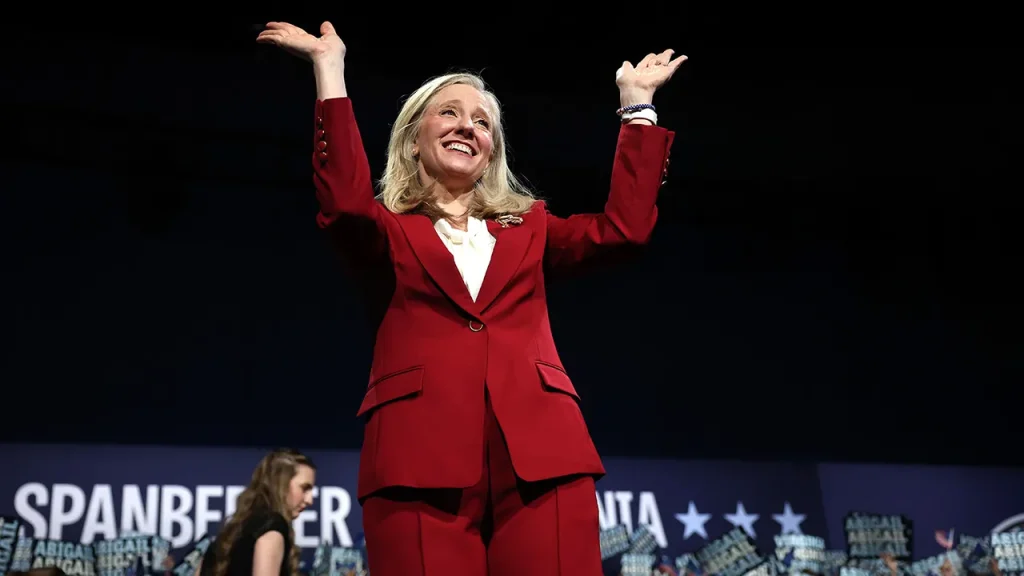Abigail Spanberger Makes History as Virginia’s First Woman Governor
In a groundbreaking election that reflects Virginia’s evolving political landscape, Democrat Abigail Spanberger has defeated Republican Winsome Earle-Sears to become Virginia’s first woman governor. The victory marks a significant moment in the Old Dominion State’s history and signals a shift back toward Democratic leadership following Republican Glenn Youngkin’s term. Spanberger’s win demonstrates not only her personal political appeal but also highlights how broader national dynamics, particularly the unpopularity of former President Donald Trump in Virginia, influenced local politics. Despite Earle-Sears’ potential to make history as the first Black woman governor of any state, Spanberger managed to build a diverse coalition of voters while effectively addressing economic concerns that resonated across demographic groups.
The election results revealed clear demographic divisions among Virginia voters. Spanberger’s victory was powered by overwhelming support from Black voters (who backed her by a nine-to-one margin), college graduates, young people, and women. Perhaps most striking was the significant gender gap, with women supporting Spanberger by a 30-point margin (65% to 35%) while men favored Earle-Sears by just 4 points – creating an extraordinary 34-point gender divide, one of the largest in recent memory. This pattern underscores the growing importance of women voters in determining election outcomes in Virginia. Meanwhile, Earle-Sears performed strongly among her base of white men, white evangelicals, and voters without college degrees, but these groups proved insufficient to overcome Spanberger’s broader coalition. Interestingly, even the historic potential of electing the first Black woman governor of any state didn’t significantly sway Black voters from their strong Democratic preferences.
Economic issues dominated the campaign and proved decisive in Spanberger’s victory. The former congresswoman strategically focused her messaging on economic concerns, particularly emphasizing how Trump administration policies affecting the federal government were hurting Virginia’s large population of federal workers – more than six in ten of whom supported her. This resonated in a state where the economy was far and away voters’ top concern, with nearly half ranking it as their most important issue. While approximately six in ten Virginia voters believed the overall economy was doing well (a group that favored Earle-Sears), most voters described their personal financial situations as either holding steady or falling behind – and both these groups backed Spanberger. Her emphasis on healthcare as a critical concern also paid dividends, as voters who prioritized this issue supported her by a four-to-one margin. The economic impact of federal budget cuts, which affected about six in ten voters’ family finances, further strengthened Spanberger’s position among those feeling financial pressure.
The election also highlighted how national political dynamics, particularly attitudes toward Trump, heavily influenced Virginia’s gubernatorial race despite Trump not being on the ballot. Nearly six in ten Virginia voters expressed disapproval of Trump, with more than half indicating strong disapproval – and the vast majority of these voters supported Spanberger. Remarkably, two-thirds of Spanberger’s supporters explicitly stated their vote was meant to signal opposition to Trump, compared to only about one-third of Earle-Sears’ voters who said theirs was to show support for him. This anti-Trump sentiment created significant headwinds for Earle-Sears, especially when combined with broader dissatisfaction about the country’s direction – only about a third of Virginia voters expressed happiness with where America is heading. While voters who were content with the national direction overwhelmingly supported Earle-Sears, the two-thirds who were discontent strongly backed Spanberger. Even more striking, among the four in ten voters who described themselves as “angry” about the country’s trajectory, more than nine in ten voted for Spanberger – demonstrating how effectively she channeled voter frustration into electoral support.
Social issues that received significant attention during the campaign, including transgender rights and controversies surrounding Democratic attorney general candidate Jay Jones, ultimately didn’t provide the advantage Earle-Sears might have hoped for. On transgender issues, Virginia voters were evenly split – half believed support for transgender rights had gone too far (Earle-Sears’ position, particularly regarding schools and girls’ sports), while the other half felt support was either appropriate or insufficient. This division largely followed partisan lines, with those concerned about overreach backing Earle-Sears by almost four to one, while those with the opposite view strongly supported Spanberger. Similarly, fewer than half of voters found controversial threatening texts sent by Democratic attorney general candidate Jay Jones disqualifying, limiting the political damage to Spanberger by association. Despite speculation that some voters might split their tickets, supporting Spanberger for governor but Republican Jason Miyares for attorney general, this pattern didn’t materialize significantly, and Democrat Jones won his race as well. Immigration enforcement presented a similar pattern, with more than half of voters believing Trump’s efforts had gone too far – a group that overwhelmingly supported Spanberger.
Spanberger’s victory represents both a personal triumph and a reflection of Virginia’s complex political identity. Though neither party enjoys overwhelming popularity in the state (half of voters view Democrats unfavorably, and more than half feel similarly about Republicans), Spanberger herself managed to maintain a net-positive personal rating, with more than half of voters viewing her favorably. This contrasted with Earle-Sears, who was viewed unfavorably by more than half of voters. Interestingly, outgoing Republican Governor Youngkin maintained positive approval ratings, with more than half of voters approving of his performance – suggesting Spanberger’s victory wasn’t necessarily a rejection of his specific leadership. Instead, it appears that broader national factors, particularly anti-Trump sentiment and economic concerns, combined with Spanberger’s personal appeal and effective campaign messaging to create a winning coalition. The election demonstrated that while Virginia remains politically competitive, the dynamics that allowed Republicans to make gains in 2021 have shifted significantly. Spanberger’s ability to unite Democrats while appealing to some independents and even a few Republicans ultimately proved decisive, while Earle-Sears struggled to generate meaningful crossover support beyond her Republican base.


